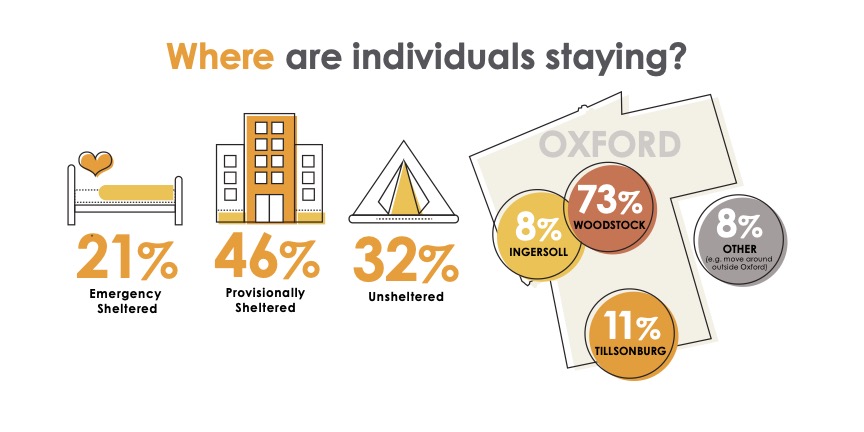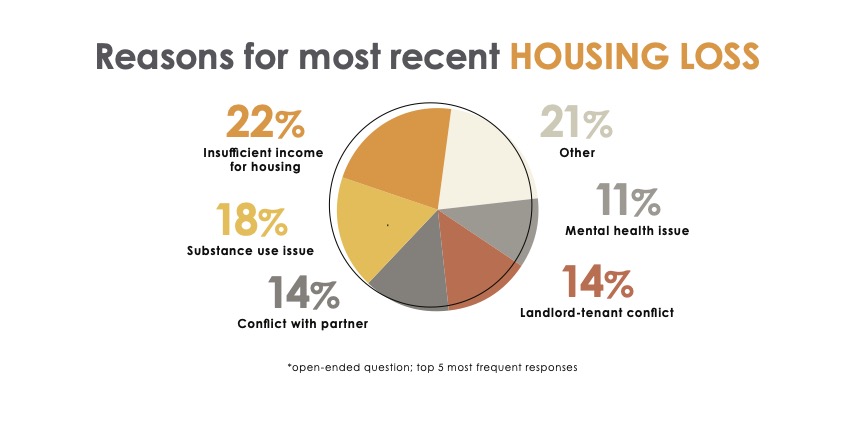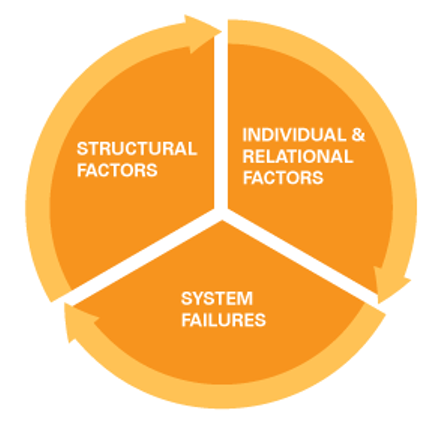About Homelessness
The Canadian Observatory on Homelessness defines Homelessness as “the situation of an individual, family or community without stable, safe, permanent, appropriate housing, or the immediate prospect, means and ability of acquiring it.”
There are different types of homelessness within this definition, including:
- Unsheltered, or absolute homelessness (i.e. living on the streets or in places not intended for people to live in);
- Emergency sheltered (i.e. staying in overnight shelters, which in Oxford County is made up of The Inn, Domestic Abuse Services Oxford, and Salvation Army Emergency Housing) and;
- Provisionally accommodated (i.e. housing is temporary and lacks security, such as ‘couch surfing’ or staying in motels).

WHAT has been Done to Understand Homelessness in Oxford County?
In November 2020, the Oxford Housing Action Collaborative completed a Registry Week to gain an understanding of the people who were experiencing homelessness at that time, their circumstances, demographics, risks, and needs.

WHERE are People Without a Home Staying?
The participants were experiencing various types of homelessness, with 21% staying in emergency shelters, 32% living unsheltered (e.g. in their car, in public, etc.), and the remaining were living in temporary circumstances with friends, family, or in motels or transitional housing.

WHO are the People Experiencing Homelessness?
During this four-day survey, we spoke with 93 individuals who did not have a home. With their dependent children, there were a total of 103 members of our community without a home who participated in Registry Week. This is likely a large underestimate of the actual population.
Of the people who participated in registry week, there were:
- 12 youth, 8 families, and the rest were single adults.
- Around 12% of the participants were over the age of 55.
- Sixty percent of the participants have lived in Oxford for over 10 years.
- The majority were men with 63%, 36% were women, and 1% identified as non-binary.

WHEN did People Become Homeless?
People identified their age the first time they didn’t have a home as early as 5 and as late as 70 years old. Over half of the participants entered homelessness after March 2020.

WHY Can’t People Get Housing?
Participants shared the factors that were keeping them from having a permanent home, and the top three answers were:
- unaffordable housing
- insufficient income for living
- and lack of availability of housing
Causes of Homelessness

Structural Issues
These include broad economic and social issues that get in the way of a person’s ability to meet their basic needs. Rising housing costs, housing availability, lack of jobs, discrimination, shifts in economy like a recession, and inadequate income are all structural issues.
Systems Failures
These occur when other systems of support fail. Difficult transitions from child welfare, lack of support for veterans, lack of support for immigrants and refugees, inadequate discharge planning from institutions from jails, hospitals, and rehab centres are systems failures.
Individual Circumstances
These affect people on a personal level or within their family or support system. For example, traumatic events (fire, job loss), personal crisis (family breakdown or domestic violence), health issues or disabilities (brain injury, chronic illness, mental health), and problems with relationships (family violence, abuse and other people’s addictions and mental health).
For most people who end up homeless, these various causes work together to create a situation where they lose their housing. These issues then also make it extremely hard to get out of homelessness.
While solutions to our current housing crisis are complex, they are possible. Many communities in the United States and Canada have been able to reduce and end homelessness.
Is It Possible to End Homelessness?
What does it mean to end homelessness?
Ending homelessness means hitting something called ‘functional zero.’ Functional zero acknowledges that there will always be people who come in and out of homelessness. However, when someone enters homelessness, they are able to get housing in a very short time so that less than 0.1% of the population in the community do not have a home. The Canadian Alliance to End Homelessness created this video to explain:
Success Stories
A number of communities have successfully ended homelessness in the United States and Canada. For example, in February 2021, London, ON announced that they have been able to end veteran homelessness in their city, and the city is putting efforts forward to end all chronic homelessness within five years.
In June 2021, Medicine Hat, AB was the first Canadian city to end chronic homelessness (i.e. reach ‘functional zero’). When they first started working toward everyone in their community having a home in 2009, they changed their approach to a Housing First model that focused on removing the compliance-based strings that were in place for housing services and instead focused on getting people in housing before assisting them with making changes in other areas of their life. As a result of this, they have helped 1200 people find housing.
A number of other communities in Canada are on track to do the same. These include: